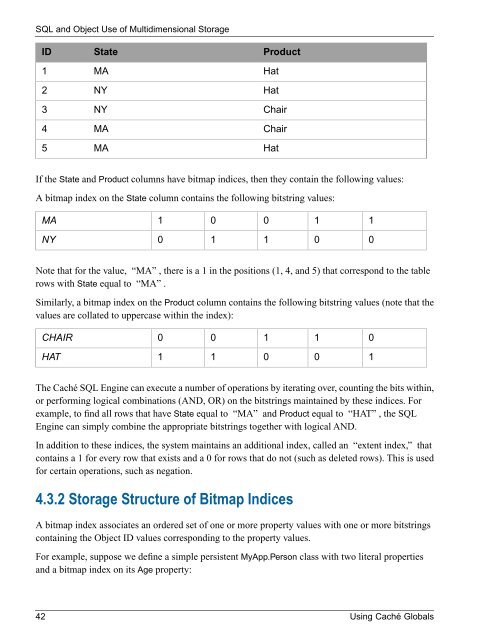Using Caché Globals - InterSystems Documentation
Using Caché Globals - InterSystems Documentation
Using Caché Globals - InterSystems Documentation
You also want an ePaper? Increase the reach of your titles
YUMPU automatically turns print PDFs into web optimized ePapers that Google loves.
SQL and Object Use of Multidimensional StorageID12345StateMANYNYMAMAProductHatHatChairChairHatIf the State and Product columns have bitmap indices, then they contain the following values:A bitmap index on the State column contains the following bitstring values:MA10011NY01100Note that for the value, “MA” , there is a 1 in the positions (1, 4, and 5) that correspond to the tablerows with State equal to “MA” .Similarly, a bitmap index on the Product column contains the following bitstring values (note that thevalues are collated to uppercase within the index):CHAIR00110HAT11001The <strong>Caché</strong> SQL Engine can execute a number of operations by iterating over, counting the bits within,or performing logical combinations (AND, OR) on the bitstrings maintained by these indices. Forexample, to find all rows that have State equal to “MA” and Product equal to “HAT” , the SQLEngine can simply combine the appropriate bitstrings together with logical AND.In addition to these indices, the system maintains an additional index, called an “extent index,” thatcontains a 1 for every row that exists and a 0 for rows that do not (such as deleted rows). This is usedfor certain operations, such as negation.4.3.2 Storage Structure of Bitmap IndicesA bitmap index associates an ordered set of one or more property values with one or more bitstringscontaining the Object ID values corresponding to the property values.For example, suppose we define a simple persistent MyApp.Person class with two literal propertiesand a bitmap index on its Age property:42 <strong>Using</strong> <strong>Caché</strong> <strong>Globals</strong>

















